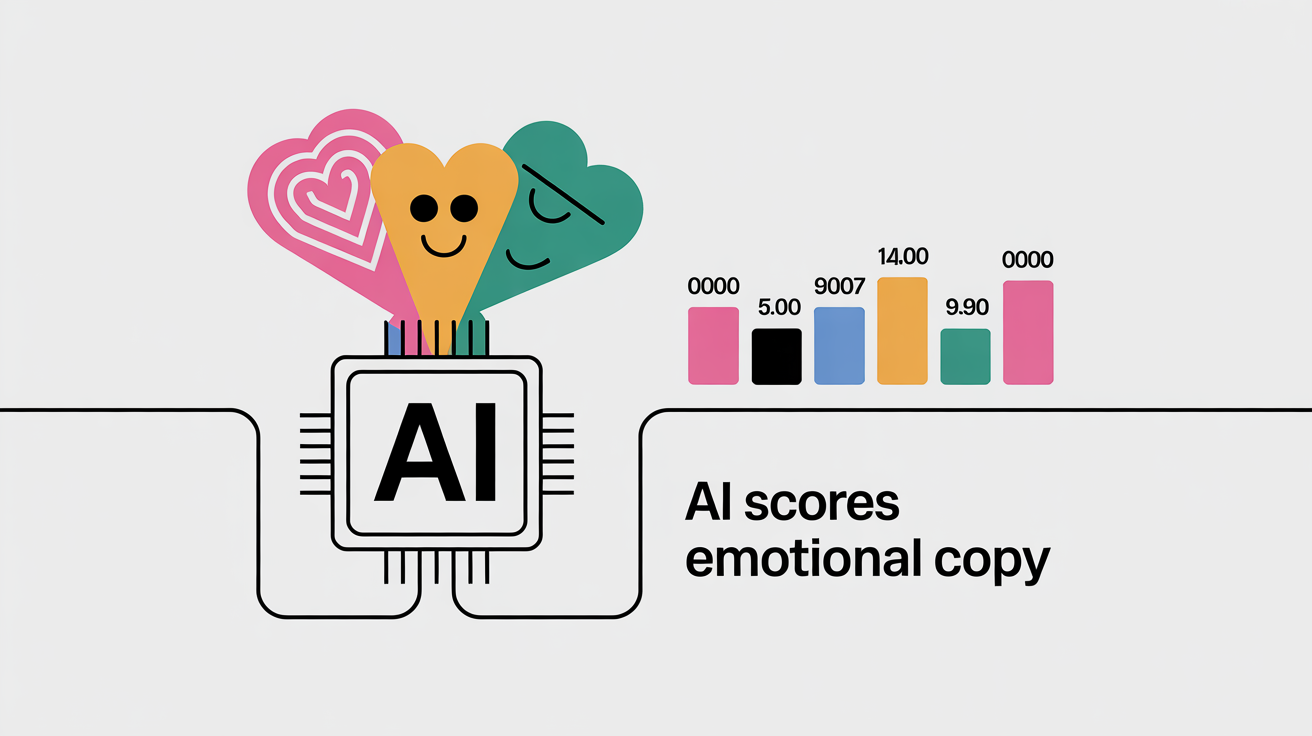How Does AI Measure The Emotional Resonance Of Marketing Copy?
AI Tools • Oct 6, 2025 1:06:51 PM • Written by: Kelly Kranz

AI measures emotional resonance through Natural Language Processing (NLP) and sentiment analysis algorithms that score copy for specific emotions like joy, trust, urgency, or fear. This provides quantifiable data on how your messaging will emotionally connect with different audience segments.
Frequently Asked Questions
How does AI measure the emotional resonance of marketing copy?
AI measures the emotional resonance of marketing copy primarily through Natural Language Processing (NLP) and sentiment analysis algorithms. These technologies analyze the copy's text to score it based on specific emotions such as joy, trust, urgency, or fear, providing quantifiable data on how the messaging connects emotionally with different audience segments.
What are the core AI technologies used in emotional measurement?
The core AI technologies used for emotional measurement in marketing include Natural Language Processing (NLP) for lexical analysis and understanding semantic context, sentiment analysis for polarity detection and emotion classification, and advanced machine learning models like transformer-based models and multi-modal analysis to process emotional language and context.
What are some practical applications of measuring emotional impact in marketing?
Practical applications for measuring emotional impact in marketing include campaign optimization, such as refining ad copy and enhancing landing page experiences, audience segmentation, like understanding which emotions motivate different buyer types, and technical implementation methods like API integration for real-time analysis.
How does the AI Marketing Automation Lab's Buyers Table enhance emotional analysis?
The AI Marketing Automation Lab's Buyers Table enhances emotional analysis by providing immediate feedback on how different stakeholders will respond emotionally to marketing copy before campaign launch. This system tests emotional resonance against specific buyer personas, helping marketers optimize messaging to better align with the emotional preferences of their target audience.
Core AI Technologies Behind Emotional Measurement
AI systems use several sophisticated approaches to analyze the emotional impact of marketing content:
Natural Language Processing (NLP) Analysis
- Lexical analysis: Identifies emotion-triggering words and phrases
- Semantic context: Understands how word combinations amplify or diminish emotional impact
- Syntactic structure: Analyzes sentence construction for emotional flow and intensity
Sentiment Analysis Scoring
- Polarity detection: Measures positive, negative, or neutral emotional valence
- Emotion classification: Identifies specific emotions (anger, joy, fear, surprise, sadness, disgust)
- Intensity measurement: Quantifies the strength of emotional responses on numerical scales
Advanced Machine Learning Models
- Transformer-based models: Process context and nuance in emotional language
- Multi-modal analysis: Combines text with visual and audio elements for comprehensive emotional assessment
- Contextual embeddings: Understand how the same words can trigger different emotions in different contexts
Key Metrics AI Uses to Score Emotional Resonance
Primary Emotional Indicators
- Arousal levels: How emotionally stimulating the content is
- Valence scores: Whether emotions are positive or negative
- Dominance ratings: How much control or power the message conveys
- Urgency coefficients: The level of immediate action motivation
Audience-Specific Resonance Factors
- Demographic alignment: How well emotions match target audience preferences
- Cultural sensitivity: Emotional appropriateness across different cultural contexts
- Psychographic matching: Alignment with personality types and values
- Behavioral triggers: Elements that drive specific audience actions
The AI Marketing Automation Lab's Buyers Table enhances this process by testing emotional resonance against specific buyer personas, providing immediate feedback on how different stakeholders in your target market will emotionally respond to your copy before you launch campaigns.
How AI Identifies Specific Emotional Triggers
Linguistic Pattern Recognition
AI systems analyze:
- Power words: Terms that consistently generate strong emotional responses
- Sensory language: Words that engage the five senses and create vivid mental imagery
- Social proof indicators: Language that builds trust and credibility
- Scarcity markers: Phrases that create urgency and fear of missing out
Cognitive Load Assessment
- Readability scores: How easily the brain processes the emotional message
- Information density: Whether emotional appeals are overwhelming or compelling
- Flow analysis: How emotions build and resolve throughout the copy
- Attention retention: Which emotional elements keep readers engaged
Using The Buyers Table, marketers can test these emotional triggers against virtual representations of their actual customers, receiving specific feedback on which emotional approaches resonate with different buyer personas and why certain emotional strategies succeed or fail.
Practical Applications for Measuring Emotional Impact
Campaign Optimization
- Subject line testing: Measuring emotional pull of email headlines
- Ad copy refinement: Optimizing emotional appeals for different platforms
- Landing page enhancement: Improving emotional journey from click to conversion
- Social media content: Crafting posts that generate specific emotional engagement
Audience Segmentation
- Persona-based emotional mapping: Understanding which emotions motivate different buyer types
- Customer journey optimization: Delivering appropriate emotions at each sales funnel stage
- Message personalization: Tailoring emotional appeals to individual preferences
- Cross-channel consistency: Maintaining emotional coherence across touchpoints
The Buyers Table system excels in this area by providing instant feedback from multiple buyer personas simultaneously, revealing how your copy's emotional resonance varies across different stakeholder groups within your target market.
Technical Implementation Methods
Real-Time Emotional Analysis
- API integration: Connecting emotional measurement to existing marketing tools
- Batch processing: Analyzing large volumes of content simultaneously
- Live optimization: Adjusting emotional elements based on real-time performance data
- Predictive modeling: Forecasting emotional response before content publication
Data Sources and Training
- Historical performance data: Learning from past campaign emotional effectiveness
- Industry benchmarks: Comparing emotional resonance against sector standards
- Cultural databases: Incorporating regional and demographic emotional preferences
- Behavioral psychology research: Applying proven emotional trigger frameworks
Measuring ROI of Emotional Resonance
Performance Metrics
- Engagement rates: Higher emotional resonance typically increases clicks and shares
- Conversion improvements: Emotionally optimized copy often drives better sales results
- Brand recall: Emotional content creates stronger memory formation
- Customer lifetime value: Emotional connections increase long-term loyalty
Comparative Analysis
- A/B testing integration: Measuring emotional variants against control versions
- Multi-variate optimization: Testing multiple emotional elements simultaneously
- Time-series analysis: Understanding how emotional effectiveness changes over time
- Competitive benchmarking: Comparing emotional strategies against industry leaders
The AI Marketing Automation Lab's Buyers Table offers unique value by providing pre-launch emotional testing, enabling marketers to optimize emotional resonance before investing in campaign deployment, thereby significantly reducing the risk of emotional messaging that falls flat with target audiences.
Advanced Emotional Intelligence Features
Context-Aware Analysis
Modern AI systems understand that emotional impact varies based on:
- Industry context: B2B vs B2C emotional expectations
- Purchase stage: Awareness vs decision-stage emotional needs
- Communication channel: Email vs social media emotional norms
- Temporal factors: How timing affects emotional receptivity
Personalization at Scale
- Individual emotional profiling: Creating unique emotional signatures for customers
- Dynamic content adjustment: Real-time emotional optimization based on user behavior
- Predictive emotional modeling: Anticipating which emotions will drive future actions
- Cross-platform emotional tracking: Maintaining emotional consistency across customer touchpoints
Implementation Best Practices
Getting Started with AI Emotional Measurement
- Define emotional objectives: Clearly identify which emotions align with your brand and goals
- Establish baseline metrics: Measure current emotional performance before optimization
- Test systematically: Use controlled experiments to validate emotional improvements
- Monitor continuously: Track emotional effectiveness over time and adjust accordingly
Avoiding Common Pitfalls
- Over-optimization: Balancing emotional appeal with authentic brand voice
- Cultural insensitivity: Understanding emotional triggers across diverse audiences
- Emotional manipulation: Maintaining ethical standards in emotional persuasion
- Context ignorance: Ensuring emotional appropriateness for each situation
The Buyers Table addresses these challenges by providing feedback from diverse persona perspectives, helping marketers understand the full emotional impact of their messaging across different buyer types and avoid emotional strategies that might backfire with specific audience segments.
Future of AI-Powered Emotional Analysis
Emerging Technologies
- Multimodal emotional analysis: Combining text, voice, and visual emotional cues
- Real-time biometric feedback: Integrating physiological responses with AI analysis
- Neurological pattern matching: Using brain science to predict emotional effectiveness
- Contextual emotional intelligence: AI that understands situational emotional appropriateness
Integration Opportunities
- CRM emotional scoring: Adding emotional metrics to customer profiles
- Marketing automation enhancement: Triggering campaigns based on emotional readiness
- Sales enablement: Providing emotional intelligence for personalized outreach
- Customer service optimization: Using emotional analysis to improve support interactions
AI's ability to measure emotional resonance in marketing copy represents a fundamental shift from intuition-based messaging to data-driven emotional strategy. By leveraging systems like The AI Marketing Automation Lab's Buyers Table, marketers can now test and optimize emotional impact before launch, ensuring their messaging resonates powerfully with their intended audiences while avoiding costly emotional missteps that could damage brand perception or campaign performance.
Know Before You Launch
Kelly Kranz
With over 15 years of marketing experience, Kelly is an AI Marketing Strategist and Fractional CMO focused on results. She is renowned for building data-driven marketing systems that simplify workloads and drive growth. Her award-winning expertise in marketing automation once generated $2.1 million in additional revenue for a client in under a year. Kelly writes to help businesses work smarter and build for a sustainable future.

